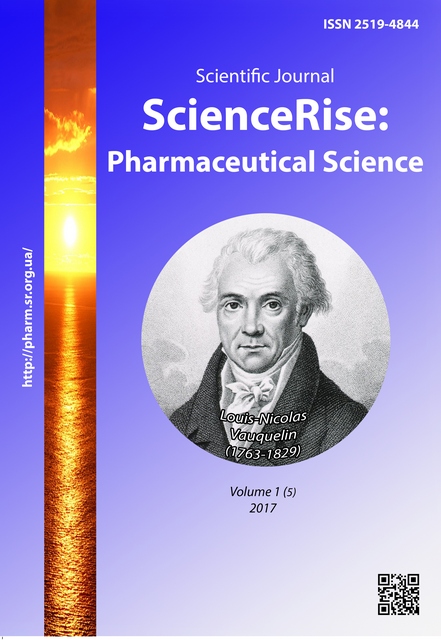Reparative properties of new combined cream on the model of thermal skin lesions in rats
DOI:
https://doi.org/10.15587/2519-4852.2017.93336Keywords:
burns, α-lipoic acid, urea, olive oil, tea tree oil, reparationAbstract
The aim of research was to study reparative properties of new combined cream on the model of thermal skin lesions in rats.
Methods. Reparative properties of the new combined remedy in the form of cream with code name “Dermalipoin” for treatment of skin inflammations and microbial diseases were studied on the model of thermal skin lesions in rats. α-lipoic acid, urea, olive oil, tea tree oil, and PEG-400 were included in the ointment. Treatment efficiency was evaluated using planimetric indicators, which provided definition: burn area, epithelialisation period, and the number of animals with wounds that healed at different times, and healing factor compared to Methyluracil ointment and Titriol gel. Morphological studies were also carried out. Connective tissue condition and collagen formation in the healing process were estimated using Van Gieson’s and Mallory’s staining methods. Collagen fibers of connective tissue were painted in red by acid fuchsin using Van Gieson’s method, collagen fibers were painted in dark blue by aniline blue using Malliry’s method, and elastic fibers were painted in red by acid fuchsin.
Results. On the model of thermal skin lesions in rats it was determined, that the use of the new cream Dermnalipoin decreased epitelization period by 9.6 days comparing to the control pathology (р≤0,05). The average degree of wound healing after the studied cream application was 37.7 %, Methyluracil ointment (reference drug) – 31 %, and Titriol gel (reference drug) – 18 % higher than the control without treatment. Results have shown that reparative properties of the studied cream (by healing factor and wound area coefficient) were higher than properties of the reference drugs.
Conclusion. Dermnalipoin cream shows high reparative activity, which is manifested in burns healing process acceleration comparing to the control pathology and reduction of the severity of cyto-destructive processes. Therefore, the further study of the new cream as promising wound-healing and anti burn remedy is perspective
References
- Pryhod'ko, T. (2015). Porjatunok bijciv ATO – sprava dosvidu i novyh tehnologij. Vashe zdorov’ja, 23-24, 20–21.
- Kozynec', G. P., Moisejenko, R. O., Komarov, M. P. (2006). Suchasnyj stan kombustiologichnoi' dopomogy naselennju Ukrai'ny ta nevidkladni zavdannja z i'i' organizacijnogo vdoskonalennja ta metodychnogo zabezpechennja. Naukovyj visnyk Uzhgorods'kogo un-tu. Serija «Medycyna», 27, 3–6.
- Nagajchuk, V. I. (2010). Suchasni pidhody do nadannja dopomogy hvorym z opikamy. Mystectvo likuvannja, 5, 24–27.
- Gajdul', K. V., Mukonin, A. A. (2005). Ranevaja infekcija: jetiologija, diagnostika i antimikrobnaja terapija. Moscow: Nauch.-inform. centr OOO «ABOLmed», 32.
- Abaev, Ju. K. (2006). Spravochnik hirurga. Rany i ranevaja infekcija. Rostov-on-Don: Feniks, 427.
- Jakovljeva, L. V., Tkachova, O. V., Butko, Ja. O., Lar'janovs'ka, Ju. B. (2013). Eksperymental'ne vyvchennja novyh preparativ dlja miscevogo likuvannja ran. Kharkiv: Vyd-vo NFaU, 52.
- Kushkun, A. A. (2007). Rukovodstvo po laboratornym metodam diagnostiki. Moscow: GJeOTAR-Media, 800.
- Pirs, Je. (1962). Gistohimija teoreticheskaja i prikladnaja. Moscow: Izd-vo inostran. lit., 962.
- Sokolovskij, V. V. (1971). Gistohimicheskie issledovanija v toksikologi. Leningrad: Medicina, 176.
- Zajcev, V. M., Lifljandskij, V. G., Marinkin, V. I. (2006). Prikladnaja medicinskaja statistika. Saint Petersburg: FOLIANT, 432.
- Lapach, S. N., Chubenko, A. V., Babich, P. N. (2001). Statisticheskie metody v medikobiologicheskih issledovanijah s ispol'zovaniem Ehsel. Kyiv: MORION, 408.
Downloads
Published
How to Cite
Issue
Section
License
Copyright (c) 2017 Надія Миколаївна Кононенко, Алі Марсель Шейхалі

This work is licensed under a Creative Commons Attribution 4.0 International License.
Our journal abides by the Creative Commons CC BY copyright rights and permissions for open access journals.








